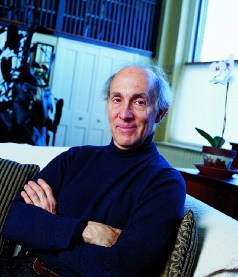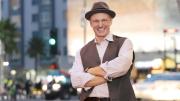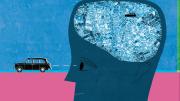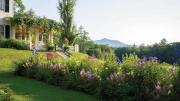Can doctors teach the rest of us to follow a piece of advice from Hippocrates"Help, or at least, do no harm" when dealing with the environment? Eric Chivian '64, M.D. '68, hopes so.
A lean, elegant man of 60, Chivian is a physician by training, but his chief mission in life is to convince people that we are dependent on natural ecosystems which we are altering in ways we do not fully understand. Our disregard of the consequences, he fears, will cause irreparable harm and already poses a serious threat to human health. Future generations, he is convinced, will view our behavior with disbelief, wondering how we could have been so shortsighted.
 |
| Eric Chivian's manner is courtly, but he pursues environmental work with firm resolve. |
| Photograph by Stu Rosner |
In 1996, with private foundation grants, Chivian established the Center for Health and the Global Environment (CHGE) at Harvard Medical School (HMS), the first of its kind at a medical school and an official "collaborating center" of the United Nations Environment Program. The School of Public Health (HSPH) had expressed early interest in the center, but Chivian held out for the medical school: "We didn't want this effort to be seen only as an area of scholarly inquiry or academic and theoretical interest. We wanted it to be seen as information that practicing doctors needed to know." Policymakers and the public, he believes, will turn increasingly to the medical community for information and understanding about the way environmental change affects health, "and they're going to be asking physicians for assistance in the formulation of policy."
In 1997 he launched the first course ever given at HMS on health and the global environment. "Human Health and Global Environmental Change" is now one of the most popular environmental courses at Harvard, attracting students throughout the University. Last fall 70 students enrolled directly and another 170 participated on-line. (The course has also become a model for similar classes at 43 other medical schools, including seven abroad.) Chivian delivers the introductory lecture but invites others to handle the restspecialists like Pellegrino University Research Professor Edward O. Wilson (see page 36); geneticist David Suzuki, host of the popular Canadian TV show, The Nature of Things; designer William McDonough, called a "Hero for the Planet" by Time magazine; and Nafis Sadik, executive director of the United Nations Population Fund.
In his lecture, Chivian minces no words in stating the themes of the course. "We are altering the physical, chemical, and biological systems of the planet in ways that have enormous implications for all living things, including ourselves," he tells his audience. "We have become separated from the environment in which we live and disconnected from the natural world. We see nature both as a hostile force to be conquered and exploited, and as an infinite resource that exists for our use alone."
Chivian has taken an interest in the natural environment since he was a boy growing up in New Jersey, but the path he followed to his current activism included a few detours. At Harvard he majored in biochemistry; at the medical school, he specialized in psychiatry. He was neither politically minded nor active in social causes. But his attitude changed, he says, after he married in 1968 and his first child was born: "That made me more conscious of the legacy that my own and all the other children of the world would inherit."
The seminal event that triggered his social activism, however, was a fellow physician's role in bringing an end to plans for a U.S. supersonic transport. Thomas Fitzpatrick, M.D. '45, then chief of dermatology at Massachusetts General Hospital, testified before Congress about how cases of malignant melanoma would increase as a result of the damage SSTs would do to the ozone layer. That incident made Chivian aware of the influence physicians could have on public policy. "I started thinking about the potential power of the medical community to shape policy," he says, "and began nurturing the idea of some kind of physicians' group that would work on environmental issues."
In 1978 he heard pediatrician Helen Caldicott speak about nuclear power. "She was electrifying," he recalls. "I talked to her subsequently about getting doctors involved in environmental work. She liked my idea but thought we should focus more narrowly on nuclear issues."
Soon after, Chivian, Caldicott, and Ira Helfand '71, M.D. (then at Mount Auburn Hospital in Cambridge), reactivated Physicians for Social Responsibility (PSR), an antinuclear group that had formed in Boston in 1960, but subsequently became dormant. PSR announced its rebirth on March 29, 1979, with a public meeting and press conference at Faneuil Hall in Boston and a full-page ad in the New England Journal of Medicine that mentioned the medical consequences of nuclear war. The night before, the nuclear power plant at Three Mile Island in Harrisburg, Pennsylvania, had a partial core meltdown.
"It was unbelievable," Chivian recalls. "The bad news was that all the science and medical reporters from Boston were in Harrisburg. The good news was that Faneuil Hall was packed with people frightened that the radioactive cloud would drift over major population areas. The really good news was that 250,000 subscribers to the Journal got their copy that day, and in two weeks we were a national organization with enough money, thanks to so many people joining us."
In 1980, PSR became the U.S. member of International Physicians for the Prevention of Nuclear War (IPPNW), which Chivian and two other HMS faculty membersHerbert Abrams, then professor of radiology, and James Muller, then assistant professor of medicinewere instrumental in founding. IPPNW won the Nobel Peace Prize in 1985 for its work toward nuclear disarmament. For Chivian that meant two things: first, physicians around the world could work together in a cause that did not recognize political boundaries or ideologies; and second, it was possible to make the abstraction of nuclear war concrete. "Our biggest contribution," he suggests, "is that we helped change public opinion about nuclear war. By organizing conferences in major cities around the world and talking about what would happen to people in New York City or London or Moscow if there were a nuclear war, we brought the subject down to a level people could understand."
Chivian now seeks to do for the environment what he did for nuclear war. As director of CHGE, he oversees campaigns on several fronts (for details, see the center's website, www.med.harvard.edu/chge). Most important to him is the HMS course, "because we are trying to educate and involve future physicians and public-health professionals. They are potentially the most powerful people in changing public opinion about, and becoming informed advocates for, the environment."
The course has already inspired several students. For example, Paul Rosenau, HMS '04, took time off to get a master's degree in pollution prevention at the University of Massachusetts at Lowell and is a coauthor of the Harvard Planning and Real Estate Environmental Procurement Guide, published last year (see www.greencampus.harvard.edu/programs/HPRE_Sustainable_Procurement.pdf). Patricia Myung, a third-year medical student at Brown, revived a Physicians for Social Responsibility chapter there after hearing Chivian speak and introduced his course to Brown's medical school. Chivian, she says, "is a great inspiration and made me realize that every environmental issue is a public-health issue that the medical profession cannot ignore." She is now the occupational and environmental health coordinator for the American Medical Student Association's Global Health Action Committee, whose mission is to raise awareness and prompt action globally on a range of environmentally related health issues.
Last fall students at HMS and HSPH formed a new group, Students for Environmental Awareness in Medicine. SEAM members want environmental issues to receive greater attention in medical school curriculums; they also plan to distribute to every medical student in the country a petition that outlines links between environmental change and adverse health effects and asks that environmental protection become a top national priority. They hope, says Frances Baxley, HMS '05, that by November 2004 "preserving the environment in the interests of preserving health will become...part of the public debate for every governor, every senator, every representative, the president, the vice president, and all major hopefuls."
Chivian himself thinks "the greatest danger for the environment lies in the profound lack of understanding among political leaders and policymakers, particularly in the United States, of the fact that human health ultimately depends on the health of the global environment." Through the center, he conducts educational programs for Congress and other federal agencies, reaching out to offices and committee members from both parties with briefings and nontechnical summaries of important scientific findings about the environment. Every spring he offers an intensive two-day course for congressional staff members; topics last year included bioterrorism. At home, CHGE works with Boston mayor Thomas Menino's office to promote energy-efficient building and transportation plans and policies. Through Meninowho chairs the U.S. Conference of Mayors Chivian hopes that concern for environmental issues will spread to other mayors.
Last Septembera decade after the World Summit on Sustainable Development held in Rio de JaneiroCHGE issued Biodiversity: Its Importance to Human Health, a 56-page report edited by Chivian. This "executive summary" presents policymakers and the general public with a foretaste of what will be the most comprehensive report ever compiled (to be published by Oxford University Press later this year) on the loss and degradation of global ecosystems and their implication for human health.
"I've come full circle," Chivian reflects. "I started out wanting to get physicians concerned about the environment, but switched to nuclear weapons. Now I'm back to environmental issuesglobal changes that have enormous consequences for human health and survival. These are issues that physicians must become involved in, for we can help people understand, perhaps better than anyone else, that we human beings are an intimate part of the environment, that our lives depend on its health. We should be able to protect the global environment the way we helped prevent a nuclear war, but it will demand all of our creativity, wisdom, and hard work. I am under no illusions about how difficult this task will be, but I feel for our children's sake that we have no choice."
~ John de Cuevas
| |
John de Cuevas, a contributing editor of this magazine, profiled Harvard's Hessel professor of biology, lepidopterist Naomi Pierce, in "A Life with Lycaenids," in the July-August 2001 issue.





